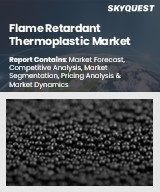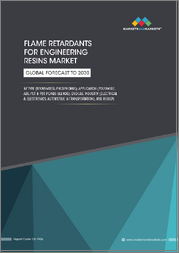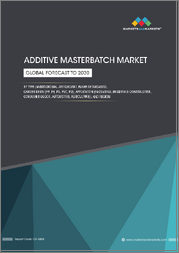
|
시장보고서
상품코드
1603314
난연제 시장 규모, 점유율, 성장 분석 : 유형별, 용도별, 최종 용도별, 지역별 - 산업 예측(2024-2031년)Flame Retardants Market Size, Share, Growth Analysis, By Type, By Application, By End-use By Region - Industry Forecast 2024-2031 |
||||||
난연제 세계 시장 규모는 2022년 72억 2,000만 달러로 평가되며, 예측 기간(2024-2031년) 동안 5.1%의 CAGR로 2023년 75억 9,000만 달러에서 2031년 113억 1,000만 달러로 성장할 것으로 예상됩니다.
세계 난연제 시장은 엄격한 화재 안전 규제와 화재 위험에 대한 인식이 높아지면서 꾸준한 성장세를 보이고 있습니다. 산업계의 난연성 소재에 대한 수요와 소비자의 화재 안전에 대한 인식이 시장 확대를 더욱 촉진하고 있습니다. 특히 개발도상국에서 급성장하고 있는 건설 부문은 건물 화재 안전 기준을 강화하는 데 필수적인 난연제로서 이러한 성장에 매우 중요한 역할을 하고 있습니다. 그러나 특정 화학 난연제와 관련된 환경 영향과 건강 위험으로 인해 시장은 큰 도전에 직면해 있습니다. 기존 제품에는 종종 독성 물질이 포함되어 있어 환경 문제와 잠재적 건강 위험에 대한 우려가 제기되고 있습니다. 이에 따라 업계는 성능 저하 없이 안전성을 우선시하는 친환경 대체품으로 눈을 돌리고 있습니다. 또한, 기계적 강도와 내구성과 같은 중요한 재료 특성과 화재 안전 요구 사항의 균형을 맞추는 것은 복잡한 문제입니다. 최종 제품의 전반적인 무결성을 보장하면서 최적의 내화성을 달성하기 위해서는 업계 내 지속적인 혁신과 협력이 필요합니다. 성능 요구 사항을 충족하는 동시에 보다 안전하고 지속가능한 솔루션을 개발하는 이중 초점은 시장의 향후 전망을 형성하는 데 매우 중요합니다.
목차
소개
- 조사 목적
- 조사 범위
- 정의
조사 방법
- 정보 조달
- 2차 데이터와 1차 데이터 방법
- 시장 규모 예측
- 시장 가정과 제한
주요 요약
- 세계 시장 전망
- 공급과 수요 동향 분석
- 부문별 기회 분석
시장 역학과 전망
- 시장 개요
- 시장 규모
- 시장 역학
- 성장 촉진요인과 기회
- 성장 억제요인과 과제
- Porters 분석과 영향
- 경쟁 기업 간의 경쟁 관계
- 대체품의 위협
- 구매자의 교섭력
- 신규 참여업체의 위협
- 공급 기업의 교섭력
주요 시장 인사이트
- 핵심성공요인
- 경쟁 정도
- 주요 투자 기회
- 시장 생태계
- 기술의 진보
- 규제 상황
- 밸류체인 분석
- 사례 연구 분석
- 고객과 구매 기준 분석
- PESTEL 분석
- 거시경제 지표
- 시장 매력 지수
- 가격 분석
난연제 시장 규모 : 유형별 & CAGR(2024-2031)
- 알루미늄 삼수화물
- 산화 안티몬
- 브롬화 난연제
- 염소화 난연제
- 인 난연제
- 질소 난연제
- 기타
- 붕산 아연
- 수산화마그네슘
- 붕소 난연제
난연제 시장 규모 : 용도별 & CAGR(2024-2031)
- 에폭시
- 불포화 폴리에스테르
- 폴리올레핀
- 폴리염화비닐
- ABS와 블렌드
- 폴리스티렌
- 폴리우레탄
난연제 시장 규모 : 최종 용도별 & CAGR(2024-2031)
- 건축·건설
- 전자기기·가전제품
- 자동차·수송
- 와이어와 케이블
- 텍스타일
- 기타
난연제 시장 규모 : 지역별 & CAGR(2024-2031)
- 북미
- 미국
- 캐나다
- 유럽
- 영국
- 독일
- 스페인
- 프랑스
- 이탈리아
- 기타 유럽
- 아시아태평양
- 중국
- 인도
- 일본
- 한국
- 기타 아시아태평양
- 라틴아메리카
- 브라질
- 기타 라틴아메리카
- 중동 및 아프리카
- GCC 국가
- 남아프리카공화국
- 기타 중동 및 아프리카
경쟁 정보
- 상위 5개사의 비교
- 주요 기업의 시장 포지셔닝(2023년)
- 주요 시장 기업이 채용한 전략
- 시장의 최근 동향
- 기업의 시장 점유율 분석(2023년)
- 주요 기업 개요
- 기업 개요
- 제품 포트폴리오 분석
- 부문별 점유율 분석
- 매출 전년비 비교(2021-2023)
주요 기업 개요
- Albemarle Corporation
- Clariant AG
- LANXESS AG
- BASF SE
- ICL Group Ltd.
- Nabaltec AG
- Huber Engineered Materials
- ADEKA Corporation
- Italmatch Chemicals S.p.A.
- Avient Corporation
- DSM-firmenich
- FRX Innovations
- DuPont
- THOR Group
- Lubrizol Corporation
결론과 추천사항
ksm 24.12.12Global Flame Retardants Market size was valued at USD 7.22 billion in 2022 and is poised to grow from USD 7.59 billion in 2023 to USD 11.31 billion by 2031, at a CAGR of 5.1% during the forecast period (2024-2031).
The global flame retardants market is on a steady growth trajectory, propelled by stringent fire safety regulations and heightened awareness of fire hazards. As industries increasingly demand flame-resistant materials, consumer awareness regarding fire safety further fuels this market's expansion. The burgeoning construction sector, especially in developing regions, plays a pivotal role in this growth, as flame retardants are vital for enhancing fire safety standards in buildings. However, the market confronts significant challenges, particularly due to the environmental impact and health risks associated with certain chemical flame retardants. Traditional products often contain toxic substances, raising substantial environmental concerns and potential health hazards. In response, the industry is pivoting towards environmentally friendly alternatives that prioritize safety without compromising performance. Additionally, balancing fire safety requirements with essential material attributes, including mechanical strength and durability, presents a complex challenge. Achieving optimal fire resistance while ensuring the overall integrity of end products necessitates ongoing innovation and collaboration within the industry. This dual focus on developing safer, more sustainable solutions alongside meeting performance demands will be critical in shaping the market's future landscape.
Top-down and bottom-up approaches were used to estimate and validate the size of the Global Flame Retardants market and to estimate the size of various other dependent submarkets. The research methodology used to estimate the market size includes the following details: The key players in the market were identified through secondary research, and their market shares in the respective regions were determined through primary and secondary research. This entire procedure includes the study of the annual and financial reports of the top market players and extensive interviews for key insights from industry leaders such as CEOs, VPs, directors, and marketing executives. All percentage shares split, and breakdowns were determined using secondary sources and verified through Primary sources. All possible parameters that affect the markets covered in this research study have been accounted for, viewed in extensive detail, verified through primary research, and analyzed to get the final quantitative and qualitative data.
Global Flame Retardants Market Segmental Analysis
Global Flame Retardants Market is segmented by Type, by Application, by End Use and by Region. Based on Type, the market is segmented into Aluminium trihydrate, Antimony oxide, Brominated flame retardants, Chlorinated flame retardants, Phosphorus flame retardants, Nitrogen flame retardants, Others(zinc borate, magnesium hydroxide, boron flame retardants). Based on Application, the market is segmented into Epoxy, Unsaturated polyester , Polyolefin, Polyvinyl chloride , Abs & blends, Polystyrene, Polyurethane . Based on End Use, the market is segmented into Building & construction, Electronics & appliances, Automotive & transportation, Wires & cables, Textiles, Others. Based on region, the market is segmented into North America, Europe, Asia Pacific, Latin America and Middle East & and Africa.
Driver of the Global Flame Retardants Market
One of the primary drivers of the global flame retardants market is the enforcement of strict fire safety regulations by governments and regulatory authorities across the globe. These regulations require the incorporation of flame-retardant materials in numerous industries to improve fire safety and mitigate the likelihood of fire-related accidents. An increased emphasis on safeguarding public welfare and protecting property significantly fuels the demand for flame retardants. As these stringent standards continue to evolve and become more prevalent, industries are compelled to adopt flame-retardant solutions, driving growth within the market and ensuring safer environments for both individuals and assets.
Restraints in the Global Flame Retardants Market
The Global Flame Retardants market faces significant restraints due to environmental and health concerns linked to certain chemical compositions. Many traditional flame retardants, especially halogenated types, are known to release toxic byproducts during combustion or may present risks throughout their lifecycle, including manufacturing, usage, and disposal. These detrimental effects on health and the environment hinder market growth as regulatory scrutiny intensifies. Consequently, there is a growing demand for safer and more eco-friendly flame retardant alternatives, prompting stakeholders to prioritize sustainable development and innovation in order to mitigate risks and align with evolving consumer and regulatory expectations.
Market Trends of the Global Flame Retardants Market
The global flame retardants market is witnessing a significant trend towards the development of lightweight and high-performance solutions, driven by the burgeoning demand from key industries like automotive, aerospace, and electronics. As these sectors strive for enhanced safety measures while optimizing material weight, flame retardant manufacturers are innovating to produce advanced formulations that offer superior fire resistance without compromising on compliance with stringent industry standards. This shift not only addresses regulatory requirements but also aligns with the broader move towards fuel efficiency and sustainability, positioning lightweight flame retardants as critical components in the manufacturing of safer, more efficient products across various applications.
Table of Contents
Introduction
- Objectives of the Study
- Scope of the Report
- Definitions
Research Methodology
- Information Procurement
- Secondary & Primary Data Methods
- Market Size Estimation
- Market Assumptions & Limitations
Executive Summary
- Global Market Outlook
- Supply & Demand Trend Analysis
- Segmental Opportunity Analysis
Market Dynamics & Outlook
- Market Overview
- Market Size
- Market Dynamics
- Driver & Opportunities
- Restraints & Challenges
- Porters Analysis & Impact
- Competitive rivalry
- Threat of substitute
- Bargaining power of buyers
- Threat of new entrants
- Bargaining power of suppliers
Key Market Insights
- Key Success Factors
- Degree of Competition
- Top Investment Pockets
- Market Ecosystem
- Technological Advancement
- Regulatory Landscape
- Value Chain Analysis
- Case Study Analysis
- Customer & Buying Criteria Analysis
- PESTEL Analysis
- Macro-Economic Indicators
- Market Attractiveness Index
- Pricing Analysis
Global Flame Retardants Market Size by Type & CAGR (2024-2031)
- Aluminium trihydrate
- Antimony oxide
- Brominated flame retardants
- Chlorinated flame retardants
- Phosphorus flame retardants
- Nitrogen flame retardants
- Others
- Zinc borate
- Magnesium hydroxide
- Boron flame retardants
Global Flame Retardants Market Size by Application & CAGR (2024-2031)
- Epoxy
- Unsaturated polyester
- Polyolefin
- Polyvinyl chloride
- Abs & blends
- Polystyrene
- Polyurethane
Global Flame Retardants Market Size by End-use & CAGR (2024-2031)
- Building & construction
- Electronics & appliances
- Automotive & transportation
- Wires & cables
- Textiles
- Others
Global Flame Retardants Market Size by Region & CAGR (2024-2031)
- North America, (by Type, by Application, by End Use)
- US
- Canada
- Europe, (by Type, by Application, by End Use)
- UK
- Germany
- Spain
- France
- Italy
- Rest of Europe
- Asia-Pacific, (by Type, by Application, by End Use)
- China
- India
- Japan
- South Korea
- Rest of Asia Pacific
- Latin America, (by Type, by Application, by End Use)
- Brazil
- Rest of Latin America
- Middle East & Africa, (by Type, by Application, by End Use)
- GCC Countries
- South Africa
- Rest of Middle East & Africa
Competitive Intelligence
- Top 5 Player Comparison
- Market Positioning of Key Players, 2023
- Strategies Adopted by Key Market Players
- Recent Developments in the Market
- Company Market Share Analysis, 2023
- Company Profiles of All Key Players
- Company Details
- Product Portfolio Analysis
- Company's Segmental Share Analysis
- Revenue Y-O-Y Comparison (2021-2023)
Key Company Profiles
- Albemarle Corporation
- Company Overview
- Business Segment Overview
- Financial Updates
- Key Developments
- Clariant AG
- Company Overview
- Business Segment Overview
- Financial Updates
- Key Developments
- LANXESS AG
- Company Overview
- Business Segment Overview
- Financial Updates
- Key Developments
- BASF SE
- Company Overview
- Business Segment Overview
- Financial Updates
- Key Developments
- ICL Group Ltd.
- Company Overview
- Business Segment Overview
- Financial Updates
- Key Developments
- Nabaltec AG
- Company Overview
- Business Segment Overview
- Financial Updates
- Key Developments
- Huber Engineered Materials
- Company Overview
- Business Segment Overview
- Financial Updates
- Key Developments
- ADEKA Corporation
- Company Overview
- Business Segment Overview
- Financial Updates
- Key Developments
- Italmatch Chemicals S.p.A.
- Company Overview
- Business Segment Overview
- Financial Updates
- Key Developments
- Avient Corporation
- Company Overview
- Business Segment Overview
- Financial Updates
- Key Developments
- DSM-firmenich
- Company Overview
- Business Segment Overview
- Financial Updates
- Key Developments
- FRX Innovations
- Company Overview
- Business Segment Overview
- Financial Updates
- Key Developments
- DuPont
- Company Overview
- Business Segment Overview
- Financial Updates
- Key Developments
- THOR Group
- Company Overview
- Business Segment Overview
- Financial Updates
- Key Developments
- Lubrizol Corporation
- Company Overview
- Business Segment Overview
- Financial Updates
- Key Developments



















